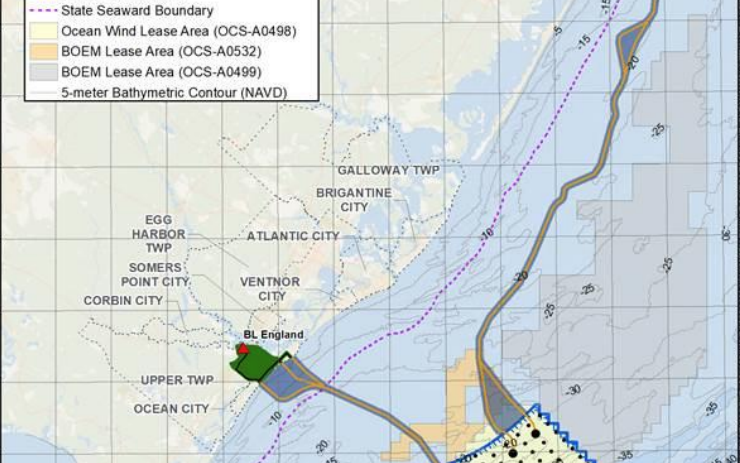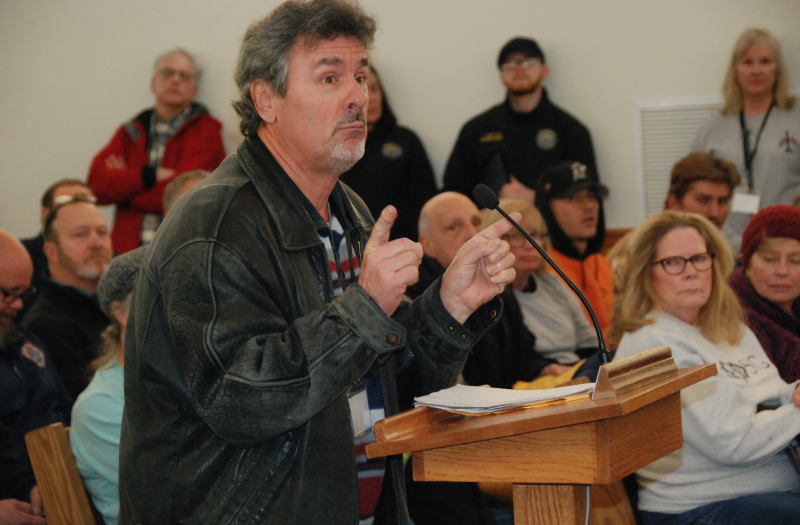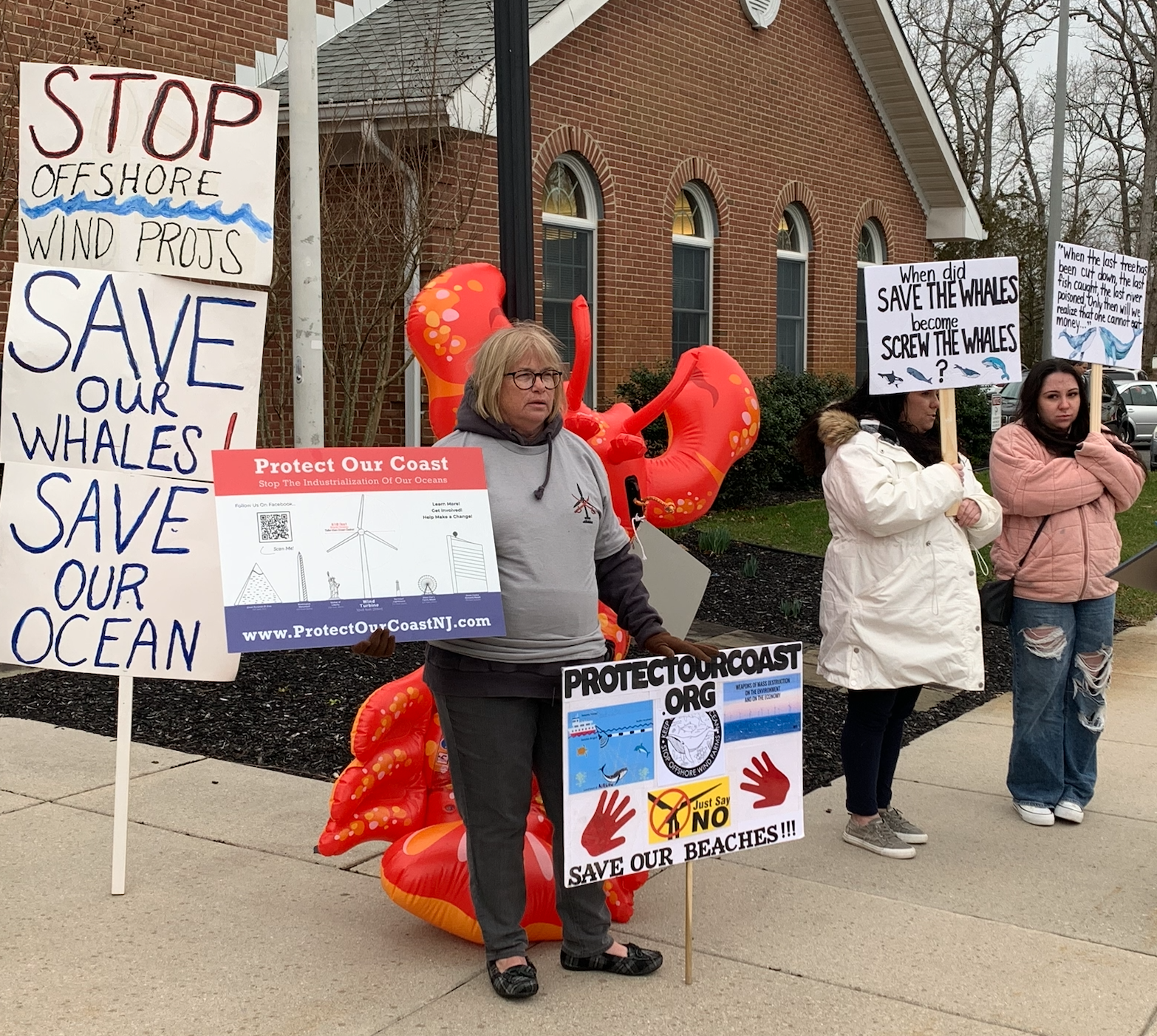Opponents of offshore wind flooded a small New Jersey town meeting Monday in a bid to block a critical cable link for Ørsted’s Ocean Wind 1 project.
Energized by social media and publicity over winter whale strandings, more than 150 protesters tried to convince Upper Township officials to at least delay plans for moving an electrical substation, where power from the planned 1,100-megawatt wind turbine array would enter the regional power grid.
The protestors came close to that goal. In the end, the Township Committee narrowly voted 3 to 2 in favor of allowing the substation move.
With two New Jersey congressmen promising to challenge offshore wind plans – and 30 Jersey Shore mayors demanding a moratorium on projects – wind power critics seem determined to fight at the local level too.
Their coalition includes the state’s commercial fishing industry. A 2022 Rutgers University study found the surf clam fleet could lose 15 percent of its revenue if boat’s can’t fish on historic grounds after wind turbines are built.
The Ocean Wind 1 export cable would come ashore on the barrier island at Ocean City, N.J., go under the back bay and connect to the grid through an electrical substation at Beesley’s Point in Upper Township on the mainland. The connection survives from one of New Jersey’s last coal-fired power plants, the defunct 447-megawatt BL England generating station.
Upper Township officials set out a redevelopment plan for the Beesley’s Point neighborhood, envisioning a waterfront district, potentially with a hotel and marina, on the Great Egg Harbor River. At the town hall on Feb. 27, they considered moving the substation – Ørsted’s preferred connection to the regional power grid – and faced a standing-room-only crowd demanding they block it.
“Ocean Wind is clearly labeled on the plan,” said Roseanne Serowartka of Ocean City. “I do understand the people here who want jobs, who want that redevelopment, but not at that cost.
“Will the people who come to that hotel want to go to a beach with industrialization?”

That future seaside vista had clearly been at the forefront of objections coming out of the beachfront towns. New York State energy planners, who were pounded early on by local political pressure from Long Island homeowners over visual impacts, pressed the federal Bureau of Ocean Energy Management to keep wind energy areas farther off those beaches to reduce visual objections.
“From Cape May to Manasquan, this shoreline will be forever changed,” said Chris Placitella of the group Save Long Beach Island, during a Feb. 11 public meeting in Brigantine, N.J. Both beach communities would look out toward the planned Atlantic Shores turbine field, a few miles north of the Ocean Wind 1 array.
The Atlantic Shores project would erect “375 Eiffel towers” that will be seen from beaches and the back bays along the Jersey Shore, said Placitella.
But opponents achieved new political momentum with news media coverage of whale strandings on Mid-Atlantic beaches, which they contend could be caused by survey work on offshore wind projects. Marine mammal experts and the National Oceanic and Atmospheric Administration roundly reject those claims, but the storyline has gained traction on conservative news media and with Republican elected officials.
The narrative is promoted by Fox News commentator Tucker Carlson and Rep. Jeff Van Drew, R-NJ, whose southern New Jersey constituents in beach towns would see the offshore turbines on clear days. Van Drew promised to start a series of Congressional hearings into how federal agencies review wind power plans and to write legislation to block the projects.
A 2021 New Jersey state law, signed by Democratic Gov. Phil Murphy, affirmed that state utility regulators can override local objections to cable routes. That’s frustrated Ocean City officials opposing the project and the cable route under their resort town.
Across the bay from Ocean City, Ocean Wind opponents saw the Upper Township deliberations as one more chance to slow the project. Upper Township Mayor Jay Newman tried to keep the sometimes raucous proceedings on track. Between cheers, jeers and applause, one objector after another spoke out, pressuring the five-member Township Committee to delay approval for moving the substation.
“It will align you with the political goals of two persons: Gov. Murphy and President Biden,” warned Michael Dean, a Middletown, N.J. activist opposing offshore wind. “You’re the only ones to put your political careers on the line…you will be linked.”
Tom Jones of the group Defend Brigantine Beach suggested Upper Township could get “a multi-million dollar payment from Ørsted” for the substation plan.

With the interest from conservative national media, offshore wind has taken on a markedly partisan cast in New Jersey. The Murphy administration is heavily committed to the Ocean Wind and Atlantic Shores projects and hopes for its New Jersey Wind Port at the mouth of the Delaware River to become a future regional hub for Mid-Atlantic projects.
In turn, environmental groups that support offshore wind are pointing to opponents’ connections to conservative think tanks and legal foundations, backed by fossil fuel interests that are paying for court challenges to wind development plans.
The Protect Our Coast group that promoted the Upper Township protest links its online donations page to the American Coalition for Ocean Protection, a project of the libertarian Caesar Rodney Institute in Delaware. The coalition has a goal of raising $500,000 toward achieving “a permanent exclusion zone 33 miles off the entire eastern seaboard of the United States and to ensure any area offered for lease meets all the requirements of federal law.”
One historic irony: Beesley’s Point was a battleground for energy and environmental activists long before the conflict over Ocean Wind.
A proposal to repower the BL England facility with a 22-mile natural gas pipeline ran afoul of New Jersey’s Pinelands preservation regulations that prohibit new pipeline construction within the 1.1 million-acre forest reserve. That particular rule dated from the late 1970s when the possibility of Mid-Atlantic offshore oil and gas exploration prompted state lawmakers to close off their coastline to Gulf of Mexico-style energy developments.
Faced with relentless opposition from environmental groups – and some Ocean City residents who objected to repowering the old power plant with natural gas – would-be buyers RC Cape May Holdings LLC finally gave up their venture in 2019.
In 2020 Upper Township officials set out their redevelopment plan for the Beesley’s Point neighborhood. The old coal plant’s 200-foot tall cooling water tower was demolished on Sept. 29.







